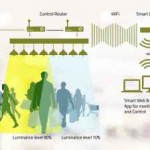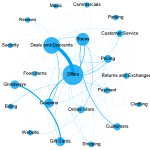5 Big Data Trends Revolutionizing Retail

With the festive season starting off with Ganesh Chaturthi, Navratra and Durga Puja, retailers are eyeing to grab the maximum share of the consumer pie. With Dhanteras and Diwali approaching, retailers across the country, whether leading e-commerce behemoths or the biggest brick and mortar retailers – all are geared up to drive sales to the brim. In order to cut thorough the intense competition, retailers are coming up with schemes, offers and discounts which are gigantic than ever before. The decisions on how to reach out and what to sell have to be made in real-time and before your competitor takes advantage of the opportunity.
So how can retailers make their mark on customer’s and drive better sales than their competitors? The answer lies in Predictive Big Data.
The golden ticket in this customer centric world is connecting data to insights and insights to decisions. Analytics is changing the retail game by providing visibility across all engagement channels to better understand customer buying patterns and behaviors.
Touching on many of the critical areas of planning and managing retail sales across all channels, here is what analytics can do for you:
• Location targeting, a new phenomenon can be adopted by retailers for better targeting the potential customers within the store. It can help businesses assess when customers stop going to a particular store and start going elsewhere, as well as give them a sense on the change in shopping pattern
• Big Data/Predictive analytics enables retailers to take prompt actions for making decisions on tracking, stocking and replenishing SKUs on a regular basis. By tracking how frequently a particular item moves from shelf to a shopping cart, retailers can map trends that are prevailing in the market. Putting this information against the number of visitors to a store shows whether or not this item is a “must have”. Hence analytics help retailers to have the right product. Big Data can also help measure operational efficiencies by mapping inventory by store. Retailers can order the right quantity of SKUs for stores not showing the same success with a particular item and can shift existing inventory to the fast moving stores
• Accurate analysis of in-store impacts allow marketers to focus on effective marketing campaigns that yield desired results. By utilizing the in-store sales funnel, marketers can devise the best opportunities that bring the highest ROI from their marketing efforts
• In-store analytics provide the tools to gain real-time actionable insights on customer behavior. As in-store product performance becomes measurable, brick-and-mortar retailers finally get answers to questions that have remained unanswered for a long time. By understanding which product performed well, retailers can strategize their campaigns accordingly. For example, how a particular marketing campaign converted regular store visitors to engaged consumers. Or for that matter, how a small change in window marketing campaign lured window shoppers to actually make a purchase decision. Consumer purchase trends can be understood by analyzing Customer sales data. Such data can reveal details such as what items are being purchased together, what all items are low in sales but can boomerang back to high demand sales
• By looking at shoppers’ buying behaviors, customer service history, response to promotions and social conversations, retailers can gain insight into each individual’s needs and preferences. This can help fast fashion retailers tweak there promotions at customer level and make it more focused / targeted to tempt buyers
• Big Data allows retailers to feed their ideas, including cut, color and pricing, to an algorithm that uses sentiment analysis to predict if the ideas will be a hit amongst consumers or not
• It also helps retailers to react faster to competition and e-competition, market shifts, and other macro-environmental factors by recognizing early signals of increasing demand or slow-downs in terms of sales. It helps allocate SKUs to stores where the demand would be and price it in a way- so it would bring maximum gross margin
Today’s brands need to look beyond the forecasting data that has historically driven retailing decisions. Instead, they must evolve as fast as their customers do by adapting to current market conditions and use real-time data as their secret weapon. By leveraging analytics solutions, retailers can more intelligently determine the most desirable and profitable experience – including products, content, prices, promotions and markdowns – to put forward at any given time. That is what customers demand, and the time to deliver is now.
Author: Sudeshna Datta Source: Economic Times

Kalyan Banga226 Posts
I am Kalyan Banga, a Post Graduate in Business Analytics from Indian Institute of Management (IIM) Calcutta, a premier management institute, ranked best B-School in Asia in FT Masters management global rankings. I have spent 14 years in field of Research & Analytics.












4 Comments
Walter Muntzenberger
October 29, 2016 at 4:23 pmAn increasing problem area in the supply chain is once goods have been received at the store (at dock) but have not made their way to the shelf and something occurs outside of normal re-stocking patterns that yields out of stock at the shelf, even though stock exists in back room. Have you seen any analytic patterns that can predict that?
Binayak
December 18, 2016 at 7:44 amHi Kalyan,
Nice article. We are a year old startup based in Kolkata building a video analytics based product for retail. It helps retailers to understand and analyse customer behavior inside brick and mortar retail stores by extracting live video feed from CCTV cameras. Would love to discuss more and get your view point. Also looking for connections and collaborations.
Regards,
Binayak
Kalyan Banga
December 18, 2016 at 8:30 amHi Binayak, Thank you for writing to us. Would love to catch up and share my view points. Please send invite on Linkedln and FB. Thanks!
Role of Big Data in Future of AI - Fusion Analytics World
November 19, 2017 at 1:21 am[…] Big data trends are revolutionizing retail and retailers expect more adoption of digital technologies between now and 2020. This is the age of hyper-digital transformation as nine additional digital technologies have joined the list of technologies. About 25% of digital leaders believe that the technologies will generate a great business impact: artificial intelligence, collaboration technologies, telepresence devices, software bots, IoT/sensors, digital currency, hardware robots and telematics and sharing economy platforms. […]